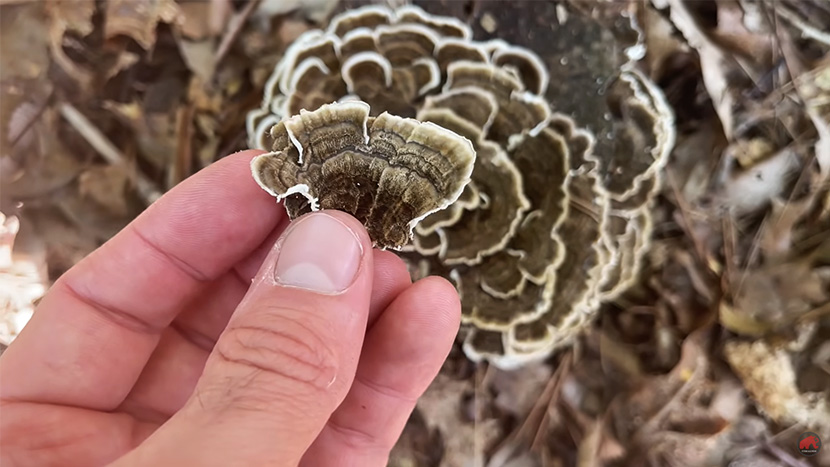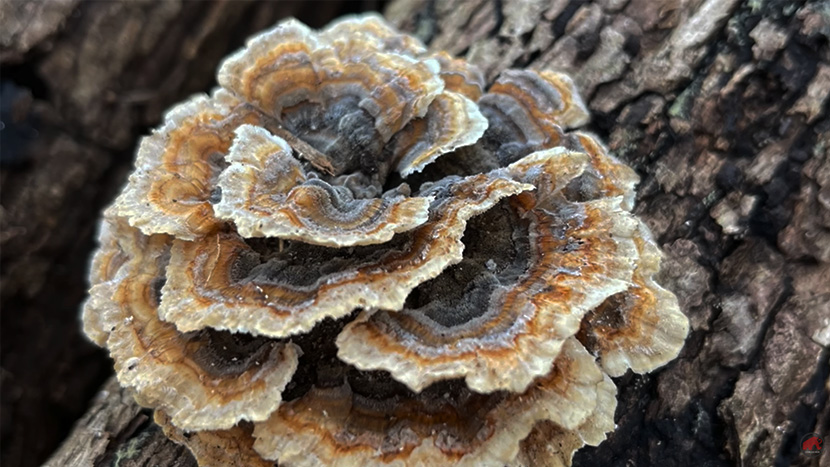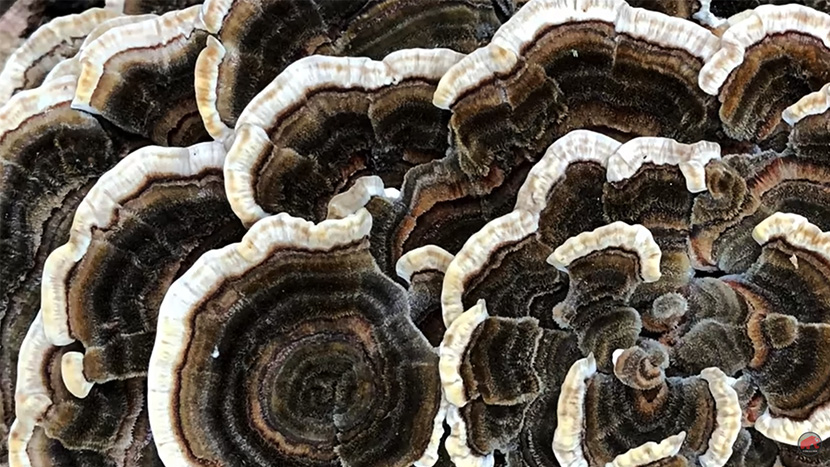Ultimate Turkey Tail Mushroom Guide
The world of fungi is one that never ceases to amaze us. From the incredible ways that they have evolved to survive, reproduce, and disperse, to the important role they have in the ecosystem, and the benefits they provide to us as functional mushrooms, this understudied and underappreciated kingdom still holds many secrets. The more we learn about mushrooms the more incredible discoveries we make and health benefits we uncover. That being said, one mushroom that has been pretty well studied is turkey tail mushroom – and here’s why:
What is Turkey Tail Mushroom?
Turkey tail – Trametes versicolor – is a saprophyte – meaning it grows on dead and decaying wood – and a polypore – which means it is a hard mushroom with lots of little pores for spore dispersal instead of gills.
This is a very widespread mushroom, practically cosmopolitan. In Holland it is called Elfenbankje (meaning fairy bench). In Germany it is called Schmetterlings-tramete (Meaning butterfly’s Tramete), and it is also found through much of Europe and the Americas as well.
This global mushroom can be harvested and then turned into a turkey tail tea (or an extract) that has a huge range of benefits for people who take it.
Medicinal Benefits of Turkey Tail
Turkey tail mushroom has a few benefits that are common in other functional mushrooms such as:
- Beta glucans which help to regulate the immune system
- Antioxidants
- Probiotics that help support a healthy gut microbiome
They also have some other surprising properties, like:
- Epsp – which helps regulate insulin
- Polysaccharides PSK and PSP – which improve and regulate the immune system, which can help the body fight off various illnesses and can even be used as cancer treatment!
These turkey tail benefits are part of why turkey tail easily made it into our top 5 for best medicinal mushrooms:
Historical Uses of Turkey Tail
Using turkey tail mushroom for medicinal purposes is nothing new. For example, it was used by native Australians to treat mouth sores, in Mexico for ringworm treatment, and in both China and Japan as cancer treatment. Unfortunately a lot of this knowledge has been lost and there are likely even more ways of using these mushrooms that we do not even know about. As people become more interested in the world of mushrooms once again, we are relearning some of what we once lost. So, if you want to try turkey tail, how should you go about it?
How Do I Find and Identify Turkey Tail Mushroom?
There are many places where you can purchase turkey tail teas and extracts, but you can also go out into the woods and forage it for yourself!
Luckily, learning to identify turkey tail mushroom is quite easy. Here are the main points for how to identify turkey tail mushroom:
- Found growing on dead and/or dying wood
- It is a shelf fungus/polypore that is hard
- Color is variant – from purplish to green hues, but in striated patterns
- Underneath you will find a totally white bottom with a bunch of little pores
- If you see any teeth or gills, this is not a turkey tail mushroom!
When foraging mushrooms for consumption you do need to be really sure that you are confident in your ID, just in case the mushroom that you are looking for has a toxic lookalike. For example, some people think that Jack O’ Lantern mushrooms look a bit like chanterelles (which are highly sought after), though there are plenty of ways to tell them apart once you know. So what about turkey tail? Does turkey tail have a toxic lookalike?

Toxic Look-Alikes of Turkey Tail
Another great thing about foraging turkey tail is that there aren’t really any toxic look-alikes that you have to be worried about! So, though you always have to be careful, you can be pretty confident in foraging this mushroom for yourself – as a long as you tick a few boxes in your ID.
If you want a bit more help with turkey tail identification, check out this video:
Summary of Turkey Tail Research
With a lot of amazing functional mushrooms, such as lion’s mane mushroom or Amanita muscaria for example, there is research being done but we have a long way to go. Though there is a long history of historical uses of many mushrooms, modern medicine doesn’t fully understand how all mushrooms impact the consumer, and this is concerning for many people. On the other hand, with turkey tail mushroom research, there have already been 100’s of studies done, and most with very positive results.
If you want to do a deep dive into medical trials with medicinal mushrooms on people yourself, you should check out Robert Roger’s book: Medicinal Mushrooms: The Human Clinical Trials. There is also a great open access review article on Turkey Tail here. Here is a brief summary of some of the research around turkey tail benefits in different areas:
Turkey Tail and Regulation of The Immune System
One of the most studied benefits of turkey tail mushroom is its ability to help regulate the immune system and improve our body’s defenses. Research suggests that compounds found in turkey tail, such as polysaccharopeptide (PSP) and polysaccharides (PSK), can enhance the activity of immune cells – such as natural killer cells and T cells. This means that turkey tail is a great supplement to help with various immune-related conditions, including cancer and infectious diseases.
Turkey Tail and Antioxidants
There have been promising studies showing that turkey tail has great antioxidant activity. The phenols and flavonoids found in this fungi are naturally available antioxidants which protect cells from free radicals. This is important to reduce inflammation in general as well as protect against cardiovascular diseases and neurodegenerative disorders.
Turkey Tail is Anti-Inflammatory
Inflammation is a key component of many chronic diseases, including arthritis, inflammatory bowel disease, and cardiovascular disease. Research suggests that turkey tail mushrooms exhibit anti-inflammatory properties by inhibiting the production of pro-inflammatory cytokines and mediators. By reducing inflammation, turkey tail mushroom may help alleviate symptoms associated with inflammatory conditions and contribute to overall health.
Gut Health
Some studies have investigated the potential of turkey tail mushrooms in promoting gut health. The previously mentioned polysaccharides in turkey tail can also act as prebiotics, promoting the growth of beneficial gut bacteria. A healthy gut microbiome is essential for digestive health, immune function, and overall well-being.

Turkey Tail and Cancer
One of the most interesting benefits of turkey tail is the support it can give in the treatment of and recovery from cancer.
One of the most incredible examples (that can be found in Robert Roger’s book) is one that looked at colon cancer survivors after surgery that took turkey tail mushroom extract. In this trial, the test group lived around twice as long as those who did not take this extract.
Another study looking at HPV patients gave a test group turkey tail extract and found that only about 40% retested for HPV as opposed to 70% in the control group that did not take turkey tail.
How does this work?
The PSP and PSK in turkey tail may exhibit anti-tumor effects by suppressing tumor growth – such as inducing apoptosis (cell death) in cancer cells – and enhancing the body’s immune response against cancer. They have also been shown to enhance the efficacy of chemotherapy. This means that turkey tail can be an excellent therapy alongside conventional cancer treatments like chemotherapy and radiation therapy.
All of this shows how much turkey tail can benefit us as a natural supplement to other medicine on our road to a healthier life, whether you just want to improve gut health or are fighting cancer and disease.
How to make Turkey Tail Tea
The best way to consume turkey tail and other polypore fungi is by making tea. By itself the mushroom is not edible. The hot water will help to break down the chitin and release all the beneficial compounds into the water so you can take them in. They really are just too hard to cook and eat!
You can brew turkey tail tea in 3 easy steps:
- Cut up the mushroom and drop it into 80 °C hot water (which is a bit less than boiling)
- Let sit and brew for 8-10 minutes
- Enjoy!
Does Turkey Tail Have Any Side effects?
Believe it or not, we have even more good news for you! Among all of these trials very few side effects have been found from consuming turkey tail – and none of which are seriously harmful.
That being said, one side effect that can occur when taking turkey tail for long periods of time is an increase in melanin production which can cause your fingernails to turn a yellowish brown. Despite this being unpleasant, it is not harmful and it is not permanent. After stopping for a short time, nails will return to their normal color. On that note, most functional mushrooms should be taken in cycles anyways, so if you are not taking the extract for something as serious as cancer, you can rotate it with other mushrooms to avoid the change in your fingernails.

Concluding thoughts
Turkey tail is an incredible functional mushroom that has had a lot of research done on it – for a good reason. This mushroom has a range of benefits, from gut health support to immune support and even cancer fighting properties, and almost no side effects. It is easy to forage on your own or purchase and can easily be made into a tea to enjoy any time of day. We hope that the research on this mushroom will inspire more studies on the range of incredible mushrooms out there that can help support a better quality of life for people everywhere.
Disclaimer: The StoneAgeMan blog is for informational purposes only and does not constitute medical advice. We are not responsible for any actions taken based on the information provided. Always consult a healthcare professional before using fungi for medicinal purposes.

